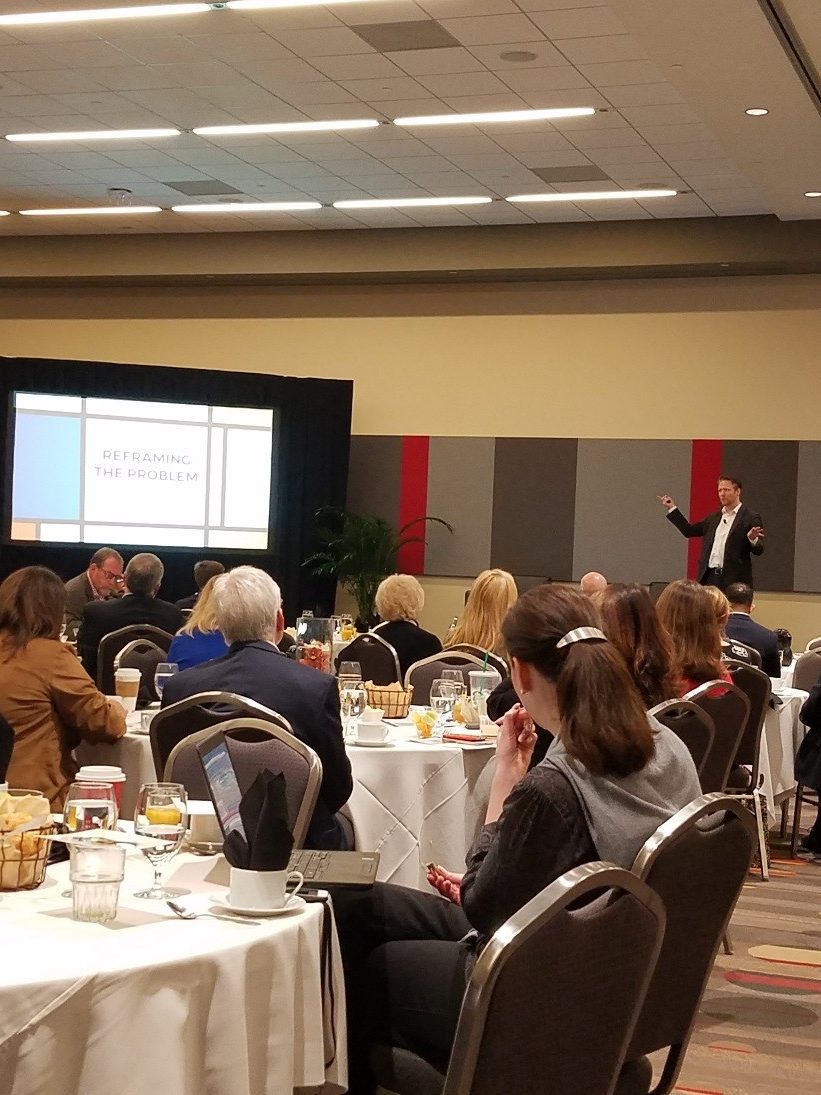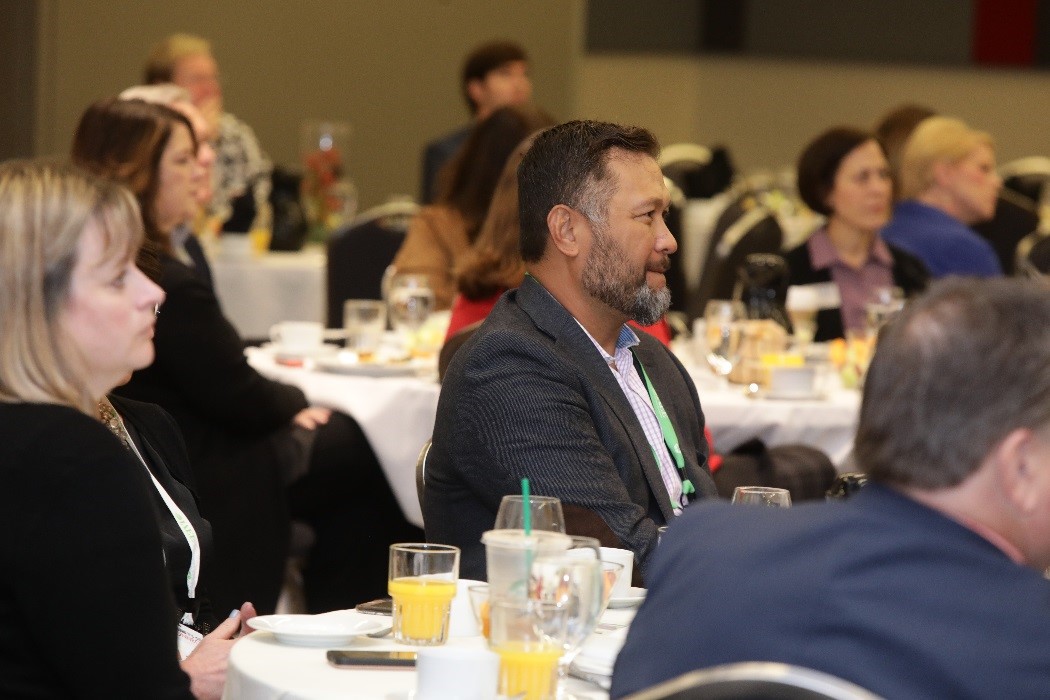Hands shaking. Warm embracing. Quiet roar of chit chats. While this may sound like any other networking event, this is the room where Executive level attendees at Expo! Expo! gather to learn how they can prepare themselves for disruptors and create innovation.

The lineup of the day’s session included:
Moderator:
- Amanda Cecil, PhD, CMP, Chair of the Department of Tourism, Conventions and Event Management, Indiana University-Purdue University Indianapolis
Panelists:
- David Ricketts, PhD, Innovation Fellow, Technology and Entrepreneurship at Harvard University
- Thomas Wedell – Wedellsborg, MA, MBA, Author of Innovation as Usual
What Is Wrong With The Tradeshow Model?
Dr. Cecil takes the stage and welcomes attendees as they take their first bites of breakfast. Not only does Dr. Cecil have over 16 years of teaching, she is an avid Crossfitter, knitter and soccer mom. She points to the big screen to share an image of a trade show. You know the one where a person is behind a booth interacting with a person in front of the booth. Nothing new there, right?

That’s the problem. The trade show model has not changed since the 1970s when McCormick Place Center opened in Chicago. Imagine wearing the same clothes and doing the same routine everyday for 40 years. That’s exactly like the trade show model. It’s the same pipe and drape, the same feel, the same look.
According to the 2017 CEIR Index, the net square footage of exhibit space is flat. The trend for number of exhibitors is flat. Not great news for the industry. The alarming part is that there’s a big disconnect between what organizers are offering and what attendees value! CEIR’s newest series, The Attendee Floor Engagement reveals that there’s also a big disconnect between what organizers offer and what exhibitors participate in.
Technology has changed everyone’s way of life and is forcing us to consider new products and processes. Attendees want more customized content and personalized experiences. The time for having the “same old” must end and now is the time to innovate.
How To Become a Disruptor
Avid sax player, creator of fine furniture and award-winning scientist and engineer, Dr. David Ricketts makes his way on stage with a smile on his face and you can already tell that he was about to drop some knowledge and blow some minds.
On each of the seats, there’s an envelope that can only be opened when told by Dr. Ricketts. He tells the room to open the envelope and attendees find a single card with an oblong Rubik’s cube. Confused by what attendees are supposed to gather from this, Dr. Ricketts tells attendees to pull out their phone. A speaker telling us to take out our phones? Is this a trick?

As we pulled out our phones and turned on our camera, we can see that the Rubik’s cube isn’t oblong, but rather the right shape. Our perception changed. Aha!
The industry has to change our perception on disruptors. Disruptors take a bad rap, but it is disruptors that bring about innovation and change. The industry cannot ignore change and disruptors because the disruption is going to happen no matter what industry you are in.
Our perception has changed, but now what? How do we bring about innovation? Dr. Ricketts shows the room a hilarious video clip of the TODAY Show during the birth of the internet and the rise of its popularity. Back then, the world was clueless on how the internet worked, but the world was aware that the internet was going to change how we would go on with our daily lives.

Dr. Ricketts shares that disruption doesn’t come from technology; the disruption comes from you finding how the technology can be of value to your clients. For example, the industry knows how to use Wi-Fi and the value it brings to event attendees. However, we don’t know how it works. Did you know Wi-Fi stands for nothing and it’s just a brand name like Starbucks and Nike? The point is that we don’t have to know how Wi-Fi works, but we do have to know its value to our attendees. Innovation happens when the value is transferred to your clients/customers.
Takeaways from Dr. Ricketts:
- Change your perspective. Changing your perspective can bring disruptive innovation. Bring someone who sees things differently.
- Disruptive innovation can hurt your organization when you ignore that there may be better solutions.
- Disruption will occur no matter what industry you’re in.
- An act of creation is first an act of disruption. Disruption should not be considered a negative, but rather as the birth of something new.
- Innovation is just about making connections and providing solutions to problems. Innovation happens when you can find the value and transfer it to your clients.
Reframing the Problem
Drummer, Game of Thrones fan, author, Thomas Wedell – Wedellsborg comes up on stage with a large easel and a marker. Why would an author on innovation use paper and a marker? Not the first thought to come to mind on innovation.
Thomas explains that organizations don’t really know the problem. Typically, when a problem is given, people will run with it and try to find a solution. People don’t stop and try to approach the problem differently. Thomas explains that the problem must be reframed. So, what does that really mean?
Thomas gives the room the “elevator is slow” problem. In this situation, building tenants complain that the elevator is slow. Usually, a person would try to fix the elevator to make it run faster. What if that’s not the problem though? Discussions occur at each table trying to reframe the problem.

Perhaps, it’s just the tenants’ perception that the elevator is slow. Maybe there’s too many people on the elevator. The elevator is fine and the building manager shut off the elevator so that tenants can’t leave without paying rent. The list goes on.
As the room sparks with ideas, Thomas drops this astonishing stat: 85% of C-suite executives tend to solve the wrong things. We shouldn’t be focused so much on looking for solutions because we may end up wasting time and energy solving the wrong problem. We need to start looking at the problem in a new way.

4 Ways In Reframing the Problem
- Challenge your thinking and perception
- For example, we hear about the time management conundrum. We say we don’t have enough time. However, it’s not about how you manage your time, but how you manage your energy. Look at the problem from a new perspective.
- Look in the mirror
- Look at your own role in creating the problem. We tend to look at problems being created from someone else.
- Challenge the objective
- What does innovation really look like? Pay explicit attention to the objectives of the parties involved, first clarifying and then challenging them.
- Bright spot
- Look to instances when the problem did not occur. Exploring such positive exceptions, sometimes called bright spots, can often uncover hidden factors whose influence the group may not have considered.
Final Thoughts
As event professionals, we have an image of what a trade show looks like. Most likely, it’s a similar image as the person next to you. It’s time to turn the trade show model upside down before we scramble to get used a new “normal.” Being innovative is not just a buzzword that only seems to be attainable by the intelligent elite. Innovation comes from providing a solution to what your clients want. Who knows your clients better than you do, right?
What are the problems you and your clients are facing right now? After saying it out loud or writing it down, take a good moment to think of the problems in a new light. Instead of trying and wasting time in finding the solution, reframe the problems so that you can find better solutions. We’re so pidgeon-holed in looking at a problem in one way that we forget to take a step back and assess all perspectives to the problem.
Embrace the innovation that is happening right now.


